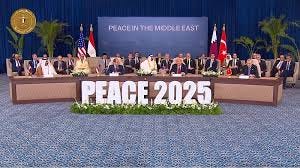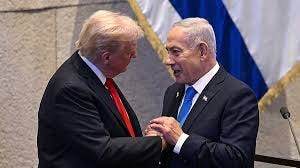The prevailing narrative surrounding the latest Israel-Hamas cease-fire deal, echoed through media and diplomatic statements since its announcement, is that this is somehow a “peace deal” that effectively ends two years of war and frees the hostages. However, this rosy view of having achieved “peace” does not fully capture the deal’s underlying intent or the reality on the ground. Instead, this deal could represent something far more significant: a quiet reconfiguration of the region’s balance of power and structures in the post-war Middle East.
A new Middle East axis may be emerging
Monday’s summit in Egypt marked a potential shift in US diplomatic strategy, moving away from partnerships with countries of the Abraham Accords and toward a new axis led by Qatar, Turkey, and Egypt. The absence of key Gulf leaders was notable, as was the lack of any reference to a two-state solution, which had previously been a central aspect of Arab engagement.
This deal, presented as a diplomatic breakthrough, may actually signal a US realignment toward working with Doha, Ankara, and Cairo as its primary partners in managing the stabilization and reconstruction of Gaza. Such a shift would represent a significant change in the US approach, moving away from the coalition that has worked with the United States and Israel toward integration, normalization, and broader reforms.
The geopolitical trade-offs of phase two
Phase two of the deal, in which the structure of a postwar Gaza is meant to take shape, will require significant pressure from outside powers on Israel and Hamas, and any complete deal will be built on complex geopolitical trade-offs.
Each key stakeholder involved appears to have extracted enough from the agreement to protect its core interests, while avoiding full accountability for the outcome.
US President Donald Trump and his team likely foresaw a pragmatic recalibration rather than a moral shift. It’s easy to see the appeal to the United States to outsource the management of stability to a secondary coalition of Qatar, Turkey, and Egypt, who would take the lead as custodians for Gaza’s reconstruction and internal stability, without the demand of a two-state solution or external funding.
For Qatar, this is an opportunity to continue its role as broker and to become the leading financier of redevelopment, leveraging its connections with Hamas. Qatar’s ongoing willingness to operate without a two-state solution or sidelining of Hamas allows it to maintain influence, particularly over its regional rivals.
Egypt’s motivations are primarily economic and security-based. This agreement is likely to enable the resumption of significant aid, an influx of foreign capital, and new development contracts, as well as Egypt’s enhanced security control in the Sinai Peninsula. This could provide substantial benefits for Egyptian firms and increase Egypt’s leverage in regional security affairs.
Meanwhile, Turkey stands to gain renewed regional relevance and economic opportunities. Ankara could benefit from reconstruction contracts, infrastructure partnerships, and increased trade, providing President Recep Tayyip Erdogan with enhanced influence both domestically and internationally.
Israel’s calculations
For Israel, the deal preserves an illusion of control and victory. Despite the failures exposed by the events of October 7, Israeli political and military leaders seem to believe they can calibrate Hamas’s strength and manage it. Although several core tenets of Israel’s security doctrine—early warning, deterrence, and even decisive victory—failed over the past two years, there has yet to be any serious attempt to change the doctrine. Instead, most evidence suggests these tenets remain intact, while Israel doubles down on different tactics to pursue these goals, such as more human intelligence over just digital monitoring. As such, Israel seems to still believe it can keep Hamas weak enough to avoid direct threats but strong enough to prevent the total collapse of local governance and avoid an intra-Palestinian civil war.
There is a real possibility that Hamas operatives could be absorbed into a new “civil administration” under the guise of an Arab stabilization mission, which would serve as a containment strategy rather than a true transition of power.
Prime Minister Benjamin Netanyahu may have seen an opportunity to conclude the war with the return of hostages, achieving a perceived moral victory. At the same time, the continued existence of Hamas serves Israel’s right-wing strategic narrative, justifying ongoing security measures, economic blockades, and political consolidation. The notion of an Arab stabilization force could serve as a cover for reconstituting Hamas operatives as new civilian police force.
Washington’s approach to Hamas
Trump indicated on Monday that Hamas had been approved for a limited period to conduct internal security operations in Gaza, suggesting a shift in the US objective from removing Hamas to reframing it as a quasi-civilian authority capable of maintaining internal order for now.
This approach by Washington would carry significant risks. The primary blind spot is that Hamas is not a rational political actor seeking incremental power, but a hybrid militant-ideological movement driven by the logic of permanent resistance to the point of large-scale mass suicidal policy. Strategies based on financial leverage, limited autonomy, or managed coexistence are likely to replicate the structural failures observed in Gaza over the past decade—periodic conflict, cyclical reconstruction, and a lack of a path to legitimate governance, let alone a future for the people of Gaza or a Palestinian state.
The US green light to Hamas’s security operations likely reflects a belief among dealmakers that Qatar’s role in reconstruction, Egypt’s economic and security interests, and Turkey’s economic ambitions could be balanced in the interest of stabilizing the conflict.
The flawed assumptions of the deal
The failure to articulate a robust disarmament and deradicalization plan for Hamas may suggest a lack of expectation that such outcomes are achievable. But consider the dealmakers: We are looking at a new trio of core actors who are not the moderate Arab reformers of the Abraham Accords, but rather parties with fundamentally different ideologies and objectives.
In Washington, Republicans often focus on interest-based negotiations in foreign policy but can succumb to idealism. Democrats, meanwhile, often emphasize principles and ideals, but may overlook the realistic interests of the actors involved. Both perspectives still risk underestimating the ideological resolve of groups like Hamas, which have continuously masked their true intentions when needed to perpetuate their armed resistance struggle.
Ultimately, the risk lies in assuming that Hamas can be managed through financial incentives or limited autonomy. There is a real possibility that the deal guarantees outcomes favorable to Hamas, allowing it to reform into a new version of civilian power, absent any genuine disarmament or deradicalization measures.
What this deal has done is elevate Qatar, Turkey, and Egypt, while leaving Hamas with some semblance of power, representing a shift in the balance of power in the region. The dynamic leaves the people of Gaza at risk, once again, of being left behind.
Melanie Robbins is the deputy director of the Atlantic Council’s Realign for Palestine project.





